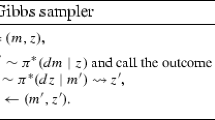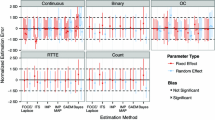Abstract
A full Bayesian statistical treatment of complex pharmacokinetic or pharmacodynamic models, in particular in a population context, gives access to powerful inference, including on model structure. Markov Chain Monte Carlo (MCMC) samplers are typically used to estimate the joint posterior parameter distribution of interest. Among MCMC samplers, the simulated tempering algorithm (TMCMC) has a number of advantages: it can sample from sharp multi-modal posteriors; it provides insight into identifiability issues useful for model simplification; it can be used to compute accurate Bayes factors for model choice; the simulated Markov chains mix quickly and have assured convergence in certain conditions. The main challenge when implementing this approach is to find an adequate scale of auxiliary inverse temperatures (perks) and associated scaling constants. We solved that problem by adaptive stochastic optimization and describe our implementation of TMCMC sampling in the GNU MCSim software. Once a grid of perks is obtained, it is easy to perform posterior-tempered MCMC sampling or likelihood-tempered MCMC (thermodynamic integration, which bridges the joint prior and the posterior parameter distributions, with assured convergence of a single sampling chain). We compare TMCMC to other samplers and demonstrate its efficient sampling of multi-modal posteriors and calculation of Bayes factors in two stylized case-studies and two realistic population pharmacokinetic inference problems, one of them involving a large PBPK model.





















Similar content being viewed by others
Data availability
Models’ code and simulation files are freely available from the official web page of GNU MCSim (www.gnu.org/software/mcsim).
Abbreviations
- CV:
-
Coefficient of variation
- MCMC:
-
Markov chain Monte Carlo
- PBPK:
-
Physiologically-based pharmacokinetic
- PK:
-
Pharmacokinetic
- SD:
-
Standard deviation
- TI:
-
Thermodynamic integration
References
Damien P, Wakefield J, Walker S (1999) Gibbs sampling for Bayesian non-conjugate and hierarchical models by using auxiliary variables. J R Stat Soc Ser B 61:331–344
Gelman A (2006) Prior distributions for variance parameters in hierarchical models (comment on article by Browne and Draper). Bayesian Anal 1:515–534
Gelman A, Bois FY, Jiang J (1996) Physiological pharmacokinetic analysis using population modeling and informative prior distributions. J Am Stat Assoc 91:1400–1412
Langdon G, Gueorguieva I, Aarons L, Karlsson M (2007) Linking preclinical and clinical whole-body physiologically based pharmacokinetic models with prior distributions in NONMEM. Eur J Clin Pharmacol 63:485–498. https://doi.org/10.1007/s00228-007-0264-x
Tsamandouras N, Rostami-Hodjegan A, Aarons L (2013) Combining the ‘bottom up’ and ‘top down’ approaches in pharmacokinetic modelling: fitting PBPK models to observed clinical data. Br J Clin Pharmacol 79:48–55. https://doi.org/10.1111/bcp.12234
Zhang X, Lionberger RA, Davit BM, Yu LX (2011) Utility of physiologically based absorption modeling in implementing quality by design in drug development. AAPS J 13:59–71. https://doi.org/10.1208/s12248-010-9250-9
Bois FY (2009) GNU MCSim: Bayesian statistical inference for SBML-coded systems biology models. Bioinformatics 25:1453–1454. https://doi.org/10.1093/bioinformatics/btp162
Hamon J, Jennings P, Bois FY (2014) Systems biology modeling of omics data: effect of cyclosporine a on the Nrf2 pathway in human renal cells. BMC Syst Biol 8:76. https://doi.org/10.1186/1752-0509-8-76
Girolami M, Calderhead B (2011) Riemann manifold Langevin and Hamiltonian Monte Carlo methods. J R Stat Soc Ser B 73:123–214. https://doi.org/10.1111/j.1467-9868.2010.00765.x
Robert C, Casella G (2011) A short history of markov chain monte carlo: subjective recollections from incomplete data. Stat Sci 26:102–115. https://doi.org/10.1214/10-STS351
Hsieh N-H, Reisfeld B, Bois FY, Chiu WA (2018) Applying a global sensitivity analysis workflow to improve the computational efficiencies in physiologically-based pharmacokinetic modeling. Front Pharmacol 9:588. https://doi.org/10.3389/fphar.2018.00588
Gelman A, Rubin DB (1992) Inference from iterative simulation using multiple sequences (with discussion). Stat Sci 7:457–511
Geyer CJ, Thompson EA (1995) Annealing Markov chain Monte Carlo with applications to ancestral inference. J Am Stat Assoc 90:909–920
Marinari E, Parisi G (1992) Simulated tempering: a new Monte Carlo scheme. Europhys Lett 19:451–458. https://doi.org/10.1209/0295-5075/19/6/002
Calderhead B, Girolami M (2009) Estimating Bayes factors via thermodynamic integration and population MCMC. Comput Stat Data Anal 53:4028–4045. https://doi.org/10.1016/j.csda.2009.07.025
Friel N, Wyse J (2012) Estimating the evidence - a review. Stat Neerlandica 66:288–308. https://doi.org/10.1111/j.1467-9574.2011.00515.x
Behrens G, Friel N, Hurn M (2012) Tuning tempered transitions. Stat Comput 22:65–78. https://doi.org/10.1007/s11222-010-9206-z
Roberts GO, Smith AFM (1994) Simple conditions for the convergence of the Gibbs sampler and Metropolis-Hastings algorithms. Stoch Process Their Appl 49:207–216
Roberts GO, Gelman A, Gilks WR (1997) Weak convergence and optimal scaling of random walk Metropolis algorithms. Ann Appl Probab 7:110–120
Robbins H, Monro S (1951) A stochastic approximation method. Ann Math Stat 22:400–407. https://doi.org/10.1214/aoms/1177729586
Yáñez JA, Remsberg CM, Sayre CL et al (2011) Flip-flop pharmacokinetics – delivering a reversal of disposition: challenges and opportunities during drug development. Ther Deliv 2:643–672. https://doi.org/10.4155/tde.11.19
Bernardo JM, Smith AFM (1994) Bayesian Theory. Wiley, New York
Trembath PW, Boobis SW (1980) Pharmacokinetics of a sustained-release theophylline formulation. Br J Clin Pharmacol 9:365–369
Mitenko PA, Ogilvie RI (1973) Pharmacokinetics of intravenous theophylline. Clin Pharmacol Ther 14:509–513
Zurlinden TJ, Reisfeld B (2016) Physiologically based modeling of the pharmacokinetics of acetaminophen and its major metabolites in humans using a Bayesian population approach. Eur J Drug Metab Pharmacokinet 41:267–280. https://doi.org/10.1007/s13318-015-0253-x
Zurlinden TJ, Reisfeld B (2017) Characterizing the effects of race/ethnicity on acetaminophen pharmacokinetics using physiologically based pharmacokinetic modeling. Eur J Drug Metab Pharmacokinet 42:143–153. https://doi.org/10.1007/s13318-016-0329-2
Ring CL, Pearce RG, Setzer RW et al (2017) Identifying populations sensitive to environmental chemicals by simulating toxicokinetic variability. Environ Int 106:105–118. https://doi.org/10.1016/j.envint.2017.06.004
R Development Core Team (2013) R: a language and environment for statistical computing. R Foundation for Statistical Computing, Vienna
Wilmes A, Bielow C, Ranninger C et al (2015) Mechanism of cisplatin proximal tubule toxicity revealed by integrating transcriptomics, proteomics, metabolomics and biokinetics. Toxicol In Vitro 30:117–127. https://doi.org/10.1016/j.tiv.2014.10.006
Paalzow LK (1975) Pharmacokinetics of theophylline in relation to increased pain sensitivity in the rat. J Pharmacokinet Biopharm 3:25–38
Melillo N, Aarons L, Magni P, Darwich AS (2019) Variance based global sensitivity analysis of physiologically based pharmacokinetic absorption models for BCS I–IV drugs. J Pharmacokinet Pharmacodyn 46:27–42. https://doi.org/10.1007/s10928-018-9615-8
Bhattacharya A, Pati D, Yang Y (2019) Bayesian fractional posteriors. Ann Stat 47:39–66. https://doi.org/10.1214/18-AOS1712
Friel N, Hurn M, Wyse J (2014) Improving power posterior estimation of statistical evidence. Stat Comput 24:709–723. https://doi.org/10.1007/s11222-013-9397-1
Miasojedow B, Moulines E, Vihola M (2013) An adaptive parallel tempering algorithm. J Comput Graph Stat 22:649–664. https://doi.org/10.1080/10618600.2013.778779
Zhou Y, Johansen AM, Aston JAD (2016) Toward automatic model comparison: an adaptive sequential monte carlo approach. J Comput Graph Stat 25:701–726. https://doi.org/10.1080/10618600.2015.1060885
Tsiros P, Bois FY, Dokoumetzidis A et al (2019) Population pharmacokinetic reanalysis of a Diazepam PBPK model: a comparison of Stan and GNU MCSim. J Pharmacokinet Pharmacodyn 46:173–192. https://doi.org/10.1007/s10928-019-09630-x
Brochot C, Casas M, Manzano-Salgado C et al (2019) Prediction of maternal and foetal exposures to perfluoroalkyl compounds in a Spanish birth cohort using toxicokinetic modelling. Toxicol Appl Pharmacol 379:114640. https://doi.org/10.1016/j.taap.2019.114640
Vyshemirsky V, Girolami M (2008) BioBayes: a software package for Bayesian inference in systems biology. Bioinformatics 24:1933–1934
Acknowledgements
We thank Joost Beltman for helpful discussion of the results.
Funding
This study was supported in part by grant 1U01FD005838 from the U.S. Food and Drug Administration (FDA) and grant P42 ES027704 from the U.S. National Institutes of Health. This article reflects the views of the authors and should not be construed to represent FDA’s views or policies.
Author information
Authors and Affiliations
Contributions
FB, N-HH, WG, BR, and WC are listed as authors. FB conceived the overall research concept and design, had overall responsibility for its implementation, and performed most analyses, simulations, and their interpretation. N-HH and WC contributed to the theophylline and acetaminophen case studies. WG ran the Hamiltonian MCMC simulations. BR provided the original acetaminophen PBPK model and data. All authors reviewed the manuscript and revised it critically.
Corresponding author
Ethics declarations
Conflict of interest
The authors declare that the research was conducted in the absence of any commercial or financial relationships that could be construed as a potential conflict of interest. FB is currently employed by the CERTARA company, but was not when this work was conducted.
Additional information
Publisher's Note
Springer Nature remains neutral with regard to jurisdictional claims in published maps and institutional affiliations.
Electronic supplementary material
Below is the link to the electronic supplementary material.
Rights and permissions
About this article
Cite this article
Bois, F.Y., Hsieh, NH., Gao, W. et al. Well-tempered MCMC simulations for population pharmacokinetic models. J Pharmacokinet Pharmacodyn 47, 543–559 (2020). https://doi.org/10.1007/s10928-020-09705-0
Received:
Accepted:
Published:
Issue Date:
DOI: https://doi.org/10.1007/s10928-020-09705-0




